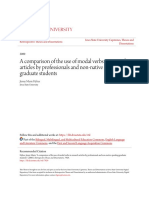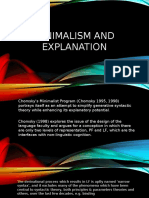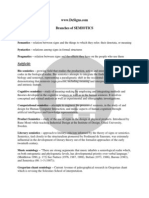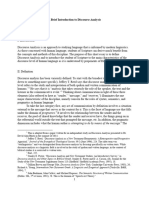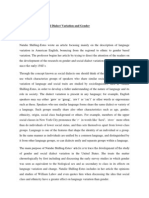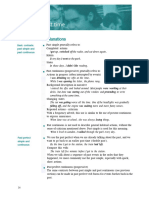75%(4)75% found this document useful (4 votes)
5K viewsThe Scope of Pragmatics
The Scope of Pragmatics
Uploaded by
Esha_Meteora_8205The modern usage of the term pragmatics is attributable to the philosopher Charles Morris. Pragmatics should be concerned with principle of language used and there is nothing to be said about the description of linguistic structure. There are 7 elements of the communicational content of an utterance, those are: 1. Truth condition or entailments 2. Conventional implicature 3. Presupposition 4. Felicity condition 5. Conversational implicature-particularized 6. Inferences based on conversational structure 7.
Copyright:
Attribution Non-Commercial (BY-NC)
Available Formats
Download as DOC, PDF, TXT or read online from Scribd
The Scope of Pragmatics
The Scope of Pragmatics
Uploaded by
Esha_Meteora_820575%(4)75% found this document useful (4 votes)
5K views2 pagesThe modern usage of the term pragmatics is attributable to the philosopher Charles Morris. Pragmatics should be concerned with principle of language used and there is nothing to be said about the description of linguistic structure. There are 7 elements of the communicational content of an utterance, those are: 1. Truth condition or entailments 2. Conventional implicature 3. Presupposition 4. Felicity condition 5. Conversational implicature-particularized 6. Inferences based on conversational structure 7.
Copyright
© Attribution Non-Commercial (BY-NC)
Available Formats
DOC, PDF, TXT or read online from Scribd
Share this document
Did you find this document useful?
Is this content inappropriate?
The modern usage of the term pragmatics is attributable to the philosopher Charles Morris. Pragmatics should be concerned with principle of language used and there is nothing to be said about the description of linguistic structure. There are 7 elements of the communicational content of an utterance, those are: 1. Truth condition or entailments 2. Conventional implicature 3. Presupposition 4. Felicity condition 5. Conversational implicature-particularized 6. Inferences based on conversational structure 7.
Copyright:
Attribution Non-Commercial (BY-NC)
Available Formats
Download as DOC, PDF, TXT or read online from Scribd
Download as doc, pdf, or txt
75%(4)75% found this document useful (4 votes)
5K views2 pagesThe Scope of Pragmatics
The Scope of Pragmatics
Uploaded by
Esha_Meteora_8205The modern usage of the term pragmatics is attributable to the philosopher Charles Morris. Pragmatics should be concerned with principle of language used and there is nothing to be said about the description of linguistic structure. There are 7 elements of the communicational content of an utterance, those are: 1. Truth condition or entailments 2. Conventional implicature 3. Presupposition 4. Felicity condition 5. Conversational implicature-particularized 6. Inferences based on conversational structure 7.
Copyright:
Attribution Non-Commercial (BY-NC)
Available Formats
Download as DOC, PDF, TXT or read online from Scribd
Download as doc, pdf, or txt
You are on page 1of 2
Putu Esha Dirtaiswara Kurniawan
070 130 5097
Summary of Scope of Pragmatics
1.1 The Origin and Historical Vagaries of the Term Pragmatics
The modern usage of the term pragmatics is attributable to the
philosopher Charles Morris (1983), whom was concern to outline, the
general shape of signs, or semiotics. Within semiotics, Morris distinguished
three distinct branches of inquiry: Syntax, Semantics and Pragmatics.
Syntax is the formal relation of signs to the objects to which the signs are
applicable. Pragmatics id the study of the relation of signs to interpreters
(1938:6)
• Each branch of semiotic, one could make the distinction between
pure studies, concern with the relevant of metalanguage and
descriptive studies, which applied the metalanguage to the
description if specific signs and their usages.
• The philosopher and logician, Champ, also very influential, he
adopted the following person of the trichotomy. Unfortunately
Carnap usage, the term of pragmatic, was confused by the adoption
of Morris’s distinction between pure and descriptive studies.
There are 7 elements of the communicational content of an utterance,
those are:
1. Truth condition or entailments
2. Conventional implicature
3. Presupposition
4. Felicity condition
5. Conversational implicature-generalized
6. Conversational implicature-particularized
7. Inferences based on conversational structure
1.2 Defining Pragmatics
Pragmatics is one of those words (societal and cognitive are others)
give the impression that something quite specific and technical is being
talked about when often in fact it has no clear meaning.
Pragmatics should be concerned with principle of language used
and there is nothing to do with the description of linguistic structure.
To invoke Chomsky’s distinction between competence and
performance pragmatics is concerned solely with performance principle of
language used.
According to Grice (1957), he distinguished between natural
meaning and non-natural meaning. So it is related to the semantics
(natural meaning) and pragmatics (non-natural meaning). Grice explains
how there can be interesting discrepancies between speaker – meaning
and sentence – meaning.
Lyons (1977) advocates distinctions between text-sentences and
system-sentences, sentences-types and sentence-tokens, utterance types
and utterance-tokens. In the cases where sentence-meaning exhausts
utterance-meaning, the same content would be assigned both to
semantics and pragmatics.
1.3 Current Interest in Pragmatics
There are a number of convergent reasons for the growth of interest
in pragmatics in recent years. Some of these are essentially historical: the
interest developed in part as or antidote to Chomsky’s treatment of
language as an abstract device, or mental ability, dissociable from the
uses, users and functions of language.
1.4 Computing Context: An Example
Abstract discussions about the scope of pragmatics like those we
have reviewed above, may well leave the reader with little feeling for the
nature of pragmatic phenomena.
There are no doubt many other [pragmatic inferences that can be
wrung from an exchange as short and insignificant as this. But this will
serve to indicate the general nature of the phenomena that pragmatic is
concern with.
You might also like
- Persuasive Language SummativeDocument3 pagesPersuasive Language Summativeapi-345043659100% (1)
- All Star Smash MouthDocument3 pagesAll Star Smash Mouthdubois antoine50% (2)
- Prophet Noble Drew Ali's Prophecies and Oral Sayings: Moorish Science Temple of AmericaDocument29 pagesProphet Noble Drew Ali's Prophecies and Oral Sayings: Moorish Science Temple of AmericaOneNation100% (3)
- Neubert and Shreve, TextualityDocument30 pagesNeubert and Shreve, TextualityBeabettyNo ratings yet
- The Reformulation of Genre and Register AnalysisDocument25 pagesThe Reformulation of Genre and Register AnalysisGabriela FernandezNo ratings yet
- Lexicology Book 1 - Alan Cruse - Lexical SemanticsDocument124 pagesLexicology Book 1 - Alan Cruse - Lexical SemanticsEva StrauchováNo ratings yet
- Discourse AnalysisDocument12 pagesDiscourse AnalysisRossa Mawar SilitongaNo ratings yet
- Comparison of HedgesDocument17 pagesComparison of HedgesSu AlmNo ratings yet
- A Comparison of The Use of Modal Verbs in Research Articles by PRDocument96 pagesA Comparison of The Use of Modal Verbs in Research Articles by PRAnthony WinklesonNo ratings yet
- Politeness As A Linguistic VariablesDocument14 pagesPoliteness As A Linguistic VariablesCaptain Amerika20 Hamka SyahrialNo ratings yet
- 121 Hedging WordsDocument9 pages121 Hedging WordsjugoslavijaNo ratings yet
- Ahmad Sarifudin (1114025022) Summary Chapter I Definition and BackgroundDocument30 pagesAhmad Sarifudin (1114025022) Summary Chapter I Definition and Backgroundabdullah al-eryaniNo ratings yet
- Book Review of CA and DA by Robin WooffittDocument3 pagesBook Review of CA and DA by Robin WooffittRENNY DNNo ratings yet
- An Analysis of Coherence and Cohesion in Writing Background For Proposal of ThesisDocument19 pagesAn Analysis of Coherence and Cohesion in Writing Background For Proposal of ThesisRachmat Fitrio100% (2)
- What Is A Text - HallidayDocument6 pagesWhat Is A Text - Hallidaybelen oroNo ratings yet
- Chomsky, N. - Persistent Topics in Linguistic TheoryDocument9 pagesChomsky, N. - Persistent Topics in Linguistic Theoryym_hNo ratings yet
- Verb ComplementationDocument19 pagesVerb ComplementationLourdes Virginia100% (1)
- Minimalism and ExplanationDocument9 pagesMinimalism and Explanationbugarin487No ratings yet
- Dependency Phonology Teeba&AzizDocument20 pagesDependency Phonology Teeba&AzizTeeba AbdulRazzaqNo ratings yet
- Code Mixing or Code SwitchingDocument22 pagesCode Mixing or Code Switchingmagneto1981100% (2)
- Branches of Semiotics PDFDocument2 pagesBranches of Semiotics PDFSergio Pisano100% (1)
- Register and Genre TheoryDocument4 pagesRegister and Genre TheoryBeaHeir100% (1)
- Discourse and PragmaticsDocument11 pagesDiscourse and Pragmaticsdian luthfiyatiNo ratings yet
- Audience and Purpose of TranslationDocument9 pagesAudience and Purpose of TranslationDharsinero SabandalNo ratings yet
- Textual Analysis A Beginners GuideDocument26 pagesTextual Analysis A Beginners GuideLorena ZentiNo ratings yet
- Pragmatics: DeixisDocument14 pagesPragmatics: DeixisA. TENRY LAWANGEN ASPAT COLLENo ratings yet
- Hyland e Tse 2004Document22 pagesHyland e Tse 2004Lígia LimaNo ratings yet
- Definitions and Scopes of PragmaticsDocument1 pageDefinitions and Scopes of PragmaticsRifeni MuisNo ratings yet
- Cross-Cultural Pragmatic Failure: Jenny ThomasDocument22 pagesCross-Cultural Pragmatic Failure: Jenny ThomasSaood KhanNo ratings yet
- Linguistic Theory: The Discourse of Fundamental Works BY Robert de BeaugrandeDocument396 pagesLinguistic Theory: The Discourse of Fundamental Works BY Robert de BeaugrandeAbdelhalim Aounali100% (5)
- Mini Research Deixis in Pragmatics-1Document10 pagesMini Research Deixis in Pragmatics-1Yuli MyeshaNo ratings yet
- Deixis: in SemanticsDocument24 pagesDeixis: in SemanticswidyaNo ratings yet
- Analysis of DeixisDocument38 pagesAnalysis of DeixisyunikeNo ratings yet
- Pragmatics of Stance: Pentti HaddingtonDocument7 pagesPragmatics of Stance: Pentti HaddingtonAlina PartenieNo ratings yet
- Semantic Field TheoryDocument6 pagesSemantic Field TheoryJonathan Harker100% (1)
- Pragmatics of Impoliteness and Rudeness PDFDocument11 pagesPragmatics of Impoliteness and Rudeness PDFNicoleta MileaNo ratings yet
- Theme and Rheme: From The Functional GrammarDocument10 pagesTheme and Rheme: From The Functional GrammarHana NurshafaNo ratings yet
- Textual MetafunctionDocument8 pagesTextual MetafunctionAniOrtiz100% (1)
- Discourse Analysis DR A Morgan PDFDocument7 pagesDiscourse Analysis DR A Morgan PDFMariana CostaNo ratings yet
- Discourse Analysis & PhonologyDocument6 pagesDiscourse Analysis & PhonologyEvitania .pNo ratings yet
- Genre and Institututions Rothery e Stenglin (1997)Document38 pagesGenre and Institututions Rothery e Stenglin (1997)Gabriel LimaNo ratings yet
- Adami Multimodality OverviewDocument35 pagesAdami Multimodality OverviewdanielefranceschiNo ratings yet
- Definition of SyntaxDocument10 pagesDefinition of SyntaxAndrianoNo ratings yet
- Word MeaningDocument3 pagesWord MeaningsusianakabanNo ratings yet
- A Brief Introduction To Discourse AnalysisDocument6 pagesA Brief Introduction To Discourse AnalysisnurulwasilaturrahmahNo ratings yet
- Sociolinguistics (Solidarity and Politeness)Document13 pagesSociolinguistics (Solidarity and Politeness)Ardiyan Syah100% (1)
- Systemic Functional Linguistics: Register & GenreDocument10 pagesSystemic Functional Linguistics: Register & GenreA. TENRY LAWANGEN ASPAT COLLENo ratings yet
- Discourse Analysis Chapter 1Document17 pagesDiscourse Analysis Chapter 1hossin karimiNo ratings yet
- Text Modality in Discourse Analysis 22Document23 pagesText Modality in Discourse Analysis 22Kareena Camille AngelesNo ratings yet
- American English Social Dialect Variation and GenderDocument4 pagesAmerican English Social Dialect Variation and Genderoctaviana100% (1)
- Thematic Progressions As Readability Factor in Academic Writing of L2 WritersDocument18 pagesThematic Progressions As Readability Factor in Academic Writing of L2 WritersMyrna Delos Santos-EscotoNo ratings yet
- Word and StructureDocument2 pagesWord and Structureshahneel TariqNo ratings yet
- Corpus Stylistic: Presented By: Quissa Marie M. Gonzales-BSED Presented To: Dr. Arjan EspirituDocument16 pagesCorpus Stylistic: Presented By: Quissa Marie M. Gonzales-BSED Presented To: Dr. Arjan EspirituQuissa GonzalesNo ratings yet
- Makalah PragmaticsDocument7 pagesMakalah PragmaticsAraNo ratings yet
- of Definition and Process of Translation by Group 1Document23 pagesof Definition and Process of Translation by Group 1ARIF IMAM SAID 1No ratings yet
- Defining Pragmatics DS 1 PDFDocument43 pagesDefining Pragmatics DS 1 PDFAyoub yopiNo ratings yet
- Defining Pragmatics DS 1Document43 pagesDefining Pragmatics DS 1Simo MijmijNo ratings yet
- Pragmatics: The Study of Its Historical Overview, Meanings, Scope and The Context in Language UseDocument7 pagesPragmatics: The Study of Its Historical Overview, Meanings, Scope and The Context in Language UseIHINOSEN IYOHANo ratings yet
- 5666 AssignmentDocument18 pages5666 Assignmentnobia jabeenNo ratings yet
- 08 Chapter2Document58 pages08 Chapter2DekaNo ratings yet
- A Pragmatic Analysis of President Obama's Speech After Mubarak's Stepping DownDocument21 pagesA Pragmatic Analysis of President Obama's Speech After Mubarak's Stepping DownAhmed Al-Gaisi93% (14)
- Introduction To SemanticsDocument4 pagesIntroduction To SemanticsMuahmmedNo ratings yet
- Language Acquisition vs. LearningDocument9 pagesLanguage Acquisition vs. LearningoverpoweredikeNo ratings yet
- Past Tenses AdvancedDocument6 pagesPast Tenses AdvancedIrving MartínNo ratings yet
- 2022 Nov NSC TimetableDocument2 pages2022 Nov NSC TimetableTanaka MuzondoNo ratings yet
- 0478 PDFDocument243 pages0478 PDFyui765100% (1)
- END-OF-COURSE-TEST-CODE-4 ScscscsDocument8 pagesEND-OF-COURSE-TEST-CODE-4 Scscscs2254060458No ratings yet
- Happiness - Sadness EssayDocument2 pagesHappiness - Sadness EssayLizbeth Morocho MorochoNo ratings yet
- English - Clasa A III ADocument10 pagesEnglish - Clasa A III ALexie BădeancăNo ratings yet
- Leger PHT Dan PTS KLS Xi TH 2020 2021Document11 pagesLeger PHT Dan PTS KLS Xi TH 2020 2021Sekar NoviaRNo ratings yet
- USA Facts For Kids USA For Kids Geography Landmarks PeopleDocument24 pagesUSA Facts For Kids USA For Kids Geography Landmarks PeopleAdamekNo ratings yet
- Homework 2 Evaluation Method For Reading Skills 5-5-12Document12 pagesHomework 2 Evaluation Method For Reading Skills 5-5-12ISABEL73533736No ratings yet
- دروس فى الترجمة الفوريةDocument13 pagesدروس فى الترجمة الفوريةMarina AdelNo ratings yet
- Unit 1 A2Document5 pagesUnit 1 A2Carmen EscobarNo ratings yet
- Academic Reading and WritingDocument4 pagesAcademic Reading and WritingNadhira ShabhaNo ratings yet
- Most Common Usage ProblemsDocument9 pagesMost Common Usage ProblemssolielcervantesNo ratings yet
- Cbse Class 11 English Core Syllabus 2024 2025Document15 pagesCbse Class 11 English Core Syllabus 2024 2025lihice2392No ratings yet
- Architecture PortfolioDocument11 pagesArchitecture Portfolioramerdedicatoria325No ratings yet
- Rike 2013 BilingualDocument18 pagesRike 2013 Bilingual30854565No ratings yet
- 语言作业任务Document11 pages语言作业任务h66h4hd7No ratings yet
- Teaching Language Through Stories VSO NZAID 2008Document160 pagesTeaching Language Through Stories VSO NZAID 2008millaisuanji37No ratings yet
- Copy of SPACECAT Graphic OrganizerDocument2 pagesCopy of SPACECAT Graphic Organizerhr8vrmxtq7No ratings yet
- DictionaryofhausrobiuoftDocument452 pagesDictionaryofhausrobiuoftMariana MartinezNo ratings yet
- It's Sunny C8Document22 pagesIt's Sunny C8AbdullohNo ratings yet
- West Bengal English PDF DownloadDocument4 pagesWest Bengal English PDF Downloadsurywanshivishal2003No ratings yet
- Diacritics: Diacritics Acute Grave Circumflex Diaeresis CedillaDocument2 pagesDiacritics: Diacritics Acute Grave Circumflex Diaeresis CedillafancsipancsiNo ratings yet
- Using Social Media To Promote EFL Learners' Speaking Skill: Perceptions From Both Teachers and LearnersDocument12 pagesUsing Social Media To Promote EFL Learners' Speaking Skill: Perceptions From Both Teachers and LearnersgelaskacaNo ratings yet
- Spanish Final Test Review and FormatDocument2 pagesSpanish Final Test Review and FormatRichard J. ShinNo ratings yet
- Hello Lucky Chops: Horns IntroDocument2 pagesHello Lucky Chops: Horns IntropyrogazzzNo ratings yet








